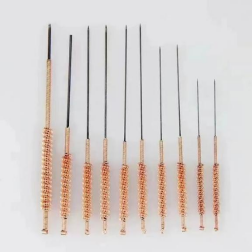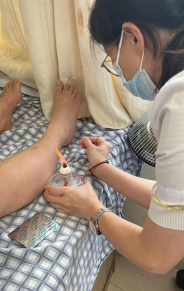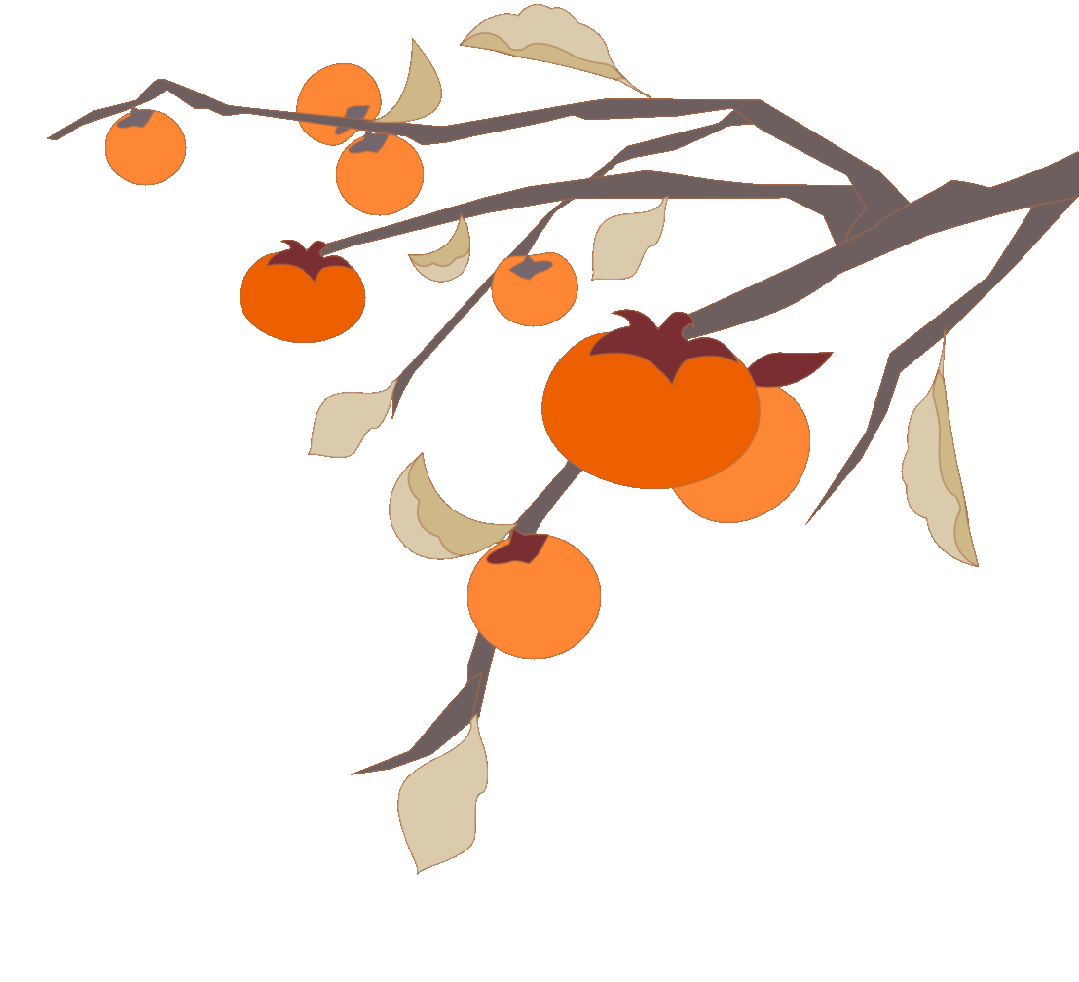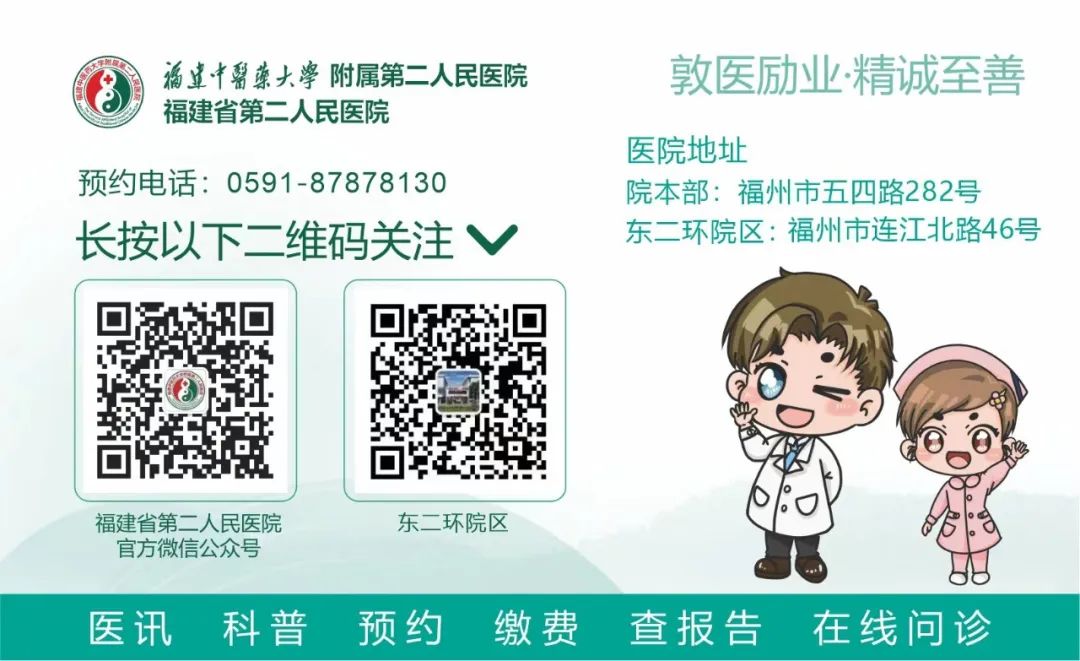Fire Needle
Fire needle therapy is first recorded in the Huangdi Neijing (Yellow Emperor’s Classic of Internal Medicine), where it is said that the “Nine Needles” originated from Fuxi, referred to as “Chuan Ci” (焠刺) or “Fan Ci” (燔刺). In ancient times, it was known by the alias of large needles and is one of the “Old Nine Needles.” Fire needle therapy involves heating specially made needles until they are red-hot and then quickly inserting them into acupoints to treat diseases.

Fire needle therapy combines the characteristics of needles and fire, making it a composite technique that provides both the stimulation of acupuncture and the warming effects of fire. It best embodies the features of Traditional Chinese Medicine (TCM) which are “simple, convenient, effective, and verified.” The effects of fire needles can be summarized as “warming,” “unblocking,” “clearing,” “tonifying,” and “dissolving.”
1. Warming Yang and Dispelling Cold, Transforming Qi and Promoting Water Metabolism
2. Warming Meridians and Unblocking Collaterals, Dispelling Stasis and Alleviating Pain
3. Nourishing Qi and Blood, Lifting Yang and Supporting the Sinking
4. Clearing Heat and Detoxifying, Expelling Pathogenic Factors
5. Dissolving Masses and Resolving Stagnation, Promoting Tissue Regeneration and Healing

Indications for Fire Needle Therapy
The Suwen: Lun on Regulating Menstruation states: “If the disease is in the tendons, adjust the tendons; if the disease is in the bones, adjust the bones; fire needle can be used for needling.” The indications for fire needle therapy include four categories: Bi syndrome (obstruction syndrome), cold syndrome, meridian and sinew syndrome, and bone diseases. In modern clinical practice, fire needle therapy is widely used across various departments including internal medicine, surgery, gynecology, dermatology, and otorhinolaryngology, demonstrating rapid effects and high efficacy.
Dermatology

Conditions such as eczema, herpes zoster, acne, neurodermatitis, warts, and vitiligo;
Surgery

Acute mastitis, mammary gland hyperplasia, thromboangiitis obliterans, lower limb varicose veins, multiple plantar warts;
Orthopedics

Cervical spondylosis, stiff neck, ankylosing spondylitis, supraspinous ligament injury, myofascial pain syndrome, lumbar disc herniation, chronic lumbar muscle strain, shoulder periarthritis;
Internal Medicine

Bronchitis, chronic gastritis, migraine, facial nerve inflammation, facial muscle spasm, sciatica, trigeminal neuralgia, gout;
Gynecology and Andrology

Conditions such as dysmenorrhea, irregular menstruation, vulvar leukoplakia, and male prostatitis;
Ophthalmology and Otorhinolaryngology

Conditions such as hordeolum (stye), acute conjunctivitis, rhinitis, chronic pharyngitis, and oral ulcers.
Practitioner Profile

Hong Xiaoping, attending physician, Master of Acupuncture, member of the Brain Disease Branch of the Fujian Acupuncture Society, member of the Pediatric Tuina Branch of the Fujian Traditional Chinese Medicine Association, and council member of the Fujian Traditional Chinese Medicine Constitution Regulation Association. She studied under Professor Liao Jun, a leading figure in the key discipline of “Tuina” at the National Administration of Traditional Chinese Medicine, and has trained at the First Affiliated Hospital of Guangzhou University of Chinese Medicine, learning Tongyuan Needling from Professor Lai Xingsheng, Qihuang Needling from Professor Chen Zhenhu, and Fire Needle Therapy from Director Wang Shuxin. She has led one provincial project and one hospital project; participated in three provincial and ministerial projects, and published nine papers. She specializes in acupuncture and herbal treatments for cervical, shoulder, lumbar, and leg pain, sequelae of stroke, facial paralysis, facial muscle spasm, insomnia, cough, rhinitis, constipation, dysmenorrhea, gout, infertility, cerebral palsy, and developmental delays, using lamp wick moxibustion, barley grain moxibustion, and fire needle therapy for skin diseases such as herpes zoster, eczema, and urticaria; employing acupoint embedding therapy for obesity, chloasma, acne, gynecological diseases, and chronic gastroenteritis.
East Second Ring Clinic Hours: Monday to Friday mornings
Department Profile
The East Second Ring Rehabilitation Department focuses on traditional Chinese medicine therapies, equipped with acupuncture and tuina treatment rooms, physiotherapy rooms, Chinese herbal fumigation treatment rooms, and moxibustion treatment rooms, with over 30 massage treatment beds. The department has advanced equipment including a computer-controlled automatic traction bed for cervical and lumbar vertebrae, computer medium-frequency therapy device, low-frequency electrical pulse therapy device, shortwave therapy device, microwave therapy device, magnetic thermal therapy device, brain circulation therapy device, swallowing disorder therapy device, lower limb CPM passive treatment device, electric standing bed, far-infrared irradiation device, and Chinese herbal fumigation treatment bed.
The department primarily conducts comprehensive TCM treatments for cervical spondylosis, lumbar disc herniation, lumbar diseases, shoulder periarthritis, sciatica, sports injuries, and joint diseases of the wrist, elbow, hip, knee, and ankle, as well as internal medicine and gynecological conditions such as dizziness, headache, facial paralysis, herpes zoster, insomnia, tinnitus, chronic gastritis, and dysmenorrhea. It also provides modern rehabilitation treatments for conditions such as stroke, pediatric cerebral palsy, and postoperative joint dysfunction in orthopedic and hand-foot surgery.
The department offers specialized therapies including small needle knife therapy, floating needle therapy, lamp wick moxibustion, fire dragon moxibustion (Du Mai moxibustion), bone setting, spinal manipulation, stretching therapy, Chinese herbal fumigation therapy, bloodletting therapy, embedding therapy, and internal herbal medicine.
Submitted by: Hong Xiaoping
Edited by: Chen Jingxian
Reviewed by: Hou Zongming, Su Zhou


